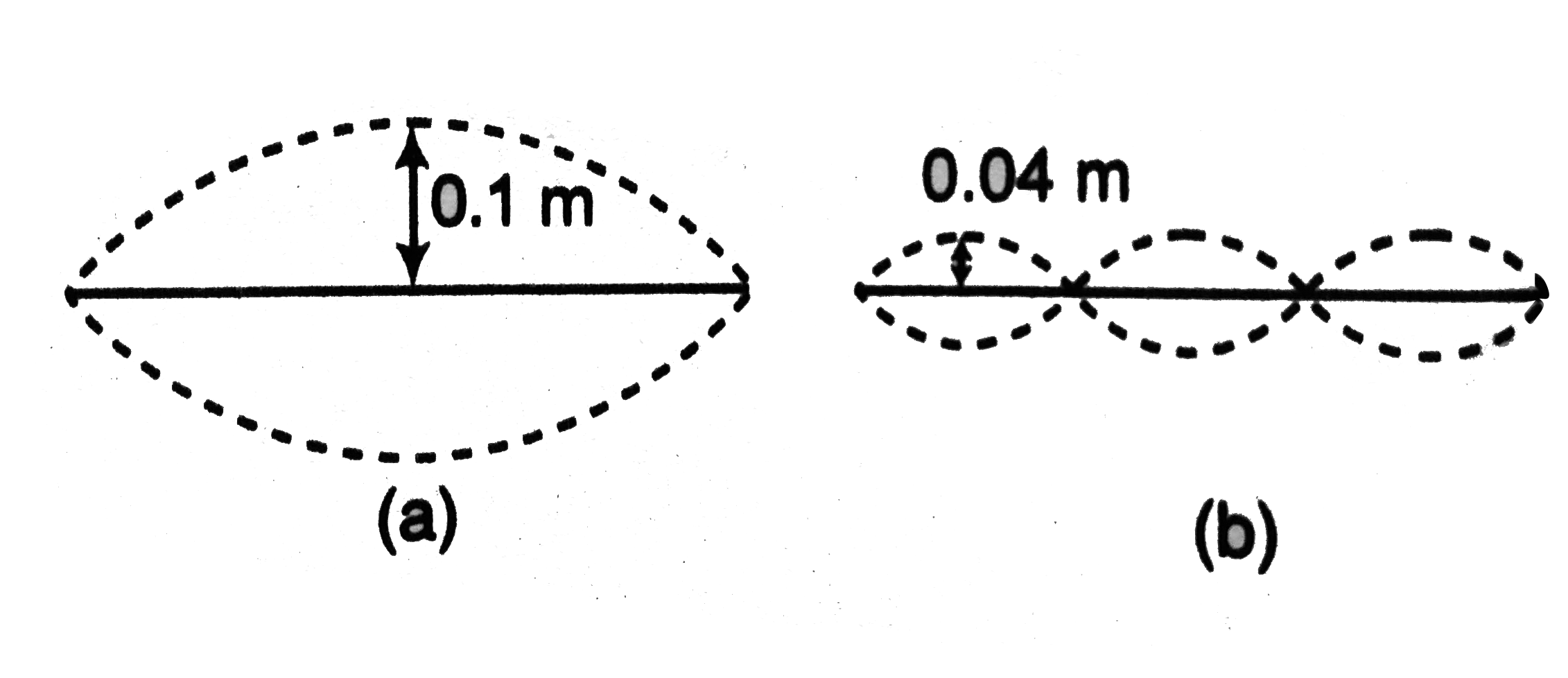A taut string for which μ=5.00×10−2kg/m under a tension of 80.0N. How much power must be supplied to the string to generate sinusoidal waves at a frequency of 60.0Hz and an amplitude of 6.00cm?
The correct Answer is:A, B
To solve the problem of how much power must be supplied to a taut string to generate sinusoidal waves at a given frequency and amplitude, we can follow these steps:
Step 1: Identify the given values
- Mass per unit length (μ) = 5.00×10−2kg/m
- Tension (T) = 80.0N
- Frequency (f) = 60.0Hz
- Amplitude (A) = 6.00cm=0.06m
Step 2: Calculate the angular frequency (ω)
The angular frequency (ω) is given by the formula:
ω=2πf
Substituting the value of frequency:
ω=2π×60.0Hz=120πrad/s
Step 3: Calculate the wave velocity (v)
The wave velocity (v) on a string is calculated using the formula:
v=√Tμ
Substituting the values of tension and mass per unit length:
v=√80.0N5.00×10−2kg/m=√1600=40.0m/s
Step 4: Calculate the power (P)
The power (P) supplied to the string to generate sinusoidal waves is given by the formula:
P=12μω2A2v
Substituting the values we have:
P=12×(5.00×10−2)×(120π)2×(0.06)2×40.0
Step 5: Calculate each component
1. Calculate ω2:
ω2=(120π)2≈14400π2≈45238.934(using π≈3.14159)
2. Calculate A2:
A2=(0.06)2=0.0036
3. Now substitute these into the power formula:
P=12×(5.00×10−2)×45238.934×0.0036×40.0
Step 6: Final calculation
Calculating the power:
P=12×0.05×45238.934×0.0036×40.0
P≈0.025×45238.934×0.0036×40.0
P≈0.025×45238.934×0.144=0.025×6514.000=162.85W
Conclusion
After performing the calculations, we find that the power required is approximately:
P≈512W
- Mass per unit length (μ) = 5.00×10−2kg/m
- Tension (T) = 80.0N
- Frequency (f) = 60.0Hz
- Amplitude (A) = 6.00cm=0.06m
The angular frequency (ω) is given by the formula:
ω=2πf
Substituting the value of frequency:
ω=2π×60.0Hz=120πrad/s
The wave velocity (v) on a string is calculated using the formula:
v=√Tμ
Substituting the values of tension and mass per unit length:
v=√80.0N5.00×10−2kg/m=√1600=40.0m/s
The power (P) supplied to the string to generate sinusoidal waves is given by the formula:
P=12μω2A2v
Substituting the values we have:
P=12×(5.00×10−2)×(120π)2×(0.06)2×40.0
1. Calculate ω2:
ω2=(120π)2≈14400π2≈45238.934(using π≈3.14159)
2. Calculate A2:
A2=(0.06)2=0.0036
3. Now substitute these into the power formula:
P=12×(5.00×10−2)×45238.934×0.0036×40.0
Calculating the power:
P=12×0.05×45238.934×0.0036×40.0
P≈0.025×45238.934×0.0036×40.0
P≈0.025×45238.934×0.144=0.025×6514.000=162.85W
After performing the calculations, we find that the power required is approximately:
P≈512W
Topper's Solved these Questions
- WAVE MOTIONBook:DC PANDEY ENGLISHChapter:WAVE MOTIONExercise:Level 1 Assertion And Reason
Explore 10 Videos
- WAVE MOTIONBook:DC PANDEY ENGLISHChapter:WAVE MOTIONExercise:Objective Questions
Explore 1 Video
- WAVE MOTIONBook:DC PANDEY ENGLISHChapter:WAVE MOTIONExercise:Exercise 17.5
Explore 6 Videos
- VECTORSBook:DC PANDEY ENGLISHChapter:VECTORSExercise:Medical enrances gallery
Explore 9 Videos
- WORK, ENERGY & POWERBook:DC PANDEY ENGLISHChapter:WORK, ENERGY & POWERExercise:Level 2 Comprehension Based
Explore 2 Videos
Similar Questions
A stretched rope having linear mass density 5×10−2kg/m is under a tension of 80N. the power that has to be supoplied to the rope to generate harmonic waves at a frequency of 60Hz and an amplitude of 2√215πm is
View SolutionA taut string for which mass per unit length μ=5.0×10−2kg/m is under tension of 80N. How much power in watt upto one decimal points must be supplied to the string to generate siusodial be supplied to the string to generate sinusoidal wave at a frequency of 6.0Hz and amplitude of 6.00cm
View Solution
Knowledge Check
A one meter long string of mass 4.9×10−4 kg is held under a tension of 19.6 N. IF the string vibrates in one segment, then the frequency of vibration will be
A200 HzB100 HzC50 HzD400 Hz
Figure shows different standing wave patterns on a string of linear mass density 4.0×10−2kg/m under a tension of 100 N. The amplitude of antinodes is indicated in each figure. The length of the string is 2.0m.
(i) Obtain the frequencies of the modes shown in figures (a) and (b).
(ii)Write down the transverse displacement y as a function of x and t for each mode. (Take the initial configuration of the wire in each mode to be as shown by the dark lines in the figure).

View SolutionA piano string having a mass per unit length equal to 5.00×103kg/m is under a tension of 1350N, Find the speed with which a wave travels on this string.
View SolutionA string of linear mass density 5.0×10−3 kg//m is stretched under a tension of 65 N between two rigid supports 60 cm apart.
(a) If the string is vibrating in its second overtone so that the amplitude at one of its antinodes is 0.25 cm, what are the maximum transverse speed and acceleration of the string at antinodes?
(b) What are these quantities at a distance 5.0 cm from an node?
View SolutionA steel wire 0.72 m long has a mass of 5.0×10−3 kg . If the wire is under a tension of 60 N, what is the speed of transverse waves on the wire ?
View SolutionIn a plane electromagnetic wave, the electric field oscillates sinusoidally at a frequency of 2×1010Hz and amplitude 48V/m. The wavelength of the wave will be-
View SolutionA stretched string of length 1m fixed at both ends , having a mass of 5×10−4kg is under a tension of 20N. It is plucked at a point situated at 25cm from one end . The stretched string would vibrate with a frequency of
View SolutionA stretched string of length 1m fixed at both ends , having a mass of 5×10−4kg is under a tension of 20N. It is plucked at a point situated at 25cm from one end . The stretched string would vibrate with a frequency of
View Solution

